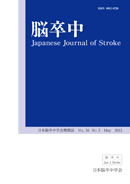Volume 31, Issue 6
Displaying 1-34 of 34 articles from this issue
- |<
- <
- 1
- >
- >|
Proceedings of the 34th Annual Meeting of the Japan Stroke Society
Presidential Address
Review
-
2009Volume 31Issue 6 Pages 395-403
Published: November 25, 2009
Released on J-STAGE: December 15, 2009
Download PDF (776K)
Presidential Lecture
-
2009Volume 31Issue 6 Pages 404-409
Published: November 25, 2009
Released on J-STAGE: December 15, 2009
Download PDF (334K)
Symposium (S1-A-01~0S1-A-08)(The Japan Stroke Society and Japanese Society on Surgery for Cerebral Stroke)
Review
-
2009Volume 31Issue 6 Pages 410-414
Published: November 25, 2009
Released on J-STAGE: December 15, 2009
Download PDF (369K) -
2009Volume 31Issue 6 Pages 415-419
Published: November 25, 2009
Released on J-STAGE: December 15, 2009
Download PDF (310K) -
2009Volume 31Issue 6 Pages 420-424
Published: November 25, 2009
Released on J-STAGE: December 15, 2009
Download PDF (294K)
Original
-
2009Volume 31Issue 6 Pages 425-432
Published: November 25, 2009
Released on J-STAGE: December 15, 2009
Download PDF (432K) -
2009Volume 31Issue 6 Pages 433-438
Published: November 25, 2009
Released on J-STAGE: December 15, 2009
Download PDF (388K)
Symposium (S1-A-09~0S1-A-14)(The Japan Stroke Society and Japanese Society on Surgery for Cerebral Stroke)
Review
-
2009Volume 31Issue 6 Pages 439-442
Published: November 25, 2009
Released on J-STAGE: December 15, 2009
Download PDF (204K) -
2009Volume 31Issue 6 Pages 443-447
Published: November 25, 2009
Released on J-STAGE: December 15, 2009
Download PDF (309K)
Symposium (S2-A-00~0S2-A-06)(The Japan Stroke Society and Japanese Society on Surgery for Cerebral Stroke)
Review
-
2009Volume 31Issue 6 Pages 448-452
Published: November 25, 2009
Released on J-STAGE: December 15, 2009
Download PDF (272K)
Original
-
2009Volume 31Issue 6 Pages 453-457
Published: November 25, 2009
Released on J-STAGE: December 15, 2009
Download PDF (335K)
Symposium (S2-A-11~S2-A-17)(The Japan Stroke Society and Japanese Society on Surgery for Cerebral Stroke)
Review
-
2009Volume 31Issue 6 Pages 458-460
Published: November 25, 2009
Released on J-STAGE: December 15, 2009
Download PDF (266K)
Original
-
2009Volume 31Issue 6 Pages 461-466
Published: November 25, 2009
Released on J-STAGE: December 15, 2009
Download PDF (326K)
Review
-
2009Volume 31Issue 6 Pages 467-471
Published: November 25, 2009
Released on J-STAGE: December 15, 2009
Download PDF (280K)
Symposium (S3-A-08~S3-A-13) (The Japan Stroke Society and Japanese Society on Surgery for Cerebral Stroke)
Review
-
2009Volume 31Issue 6 Pages 472-476
Published: November 25, 2009
Released on J-STAGE: December 15, 2009
Download PDF (352K) -
2009Volume 31Issue 6 Pages 477-482
Published: November 25, 2009
Released on J-STAGE: December 15, 2009
Download PDF (388K)
Original
-
2009Volume 31Issue 6 Pages 483-490
Published: November 25, 2009
Released on J-STAGE: December 15, 2009
Download PDF (441K)
Symposium (S3-A-14~S3-A-20) (The Japan Stroke Society and Japanese Society on Surgery for Cerebral Stroke)
Review
-
2009Volume 31Issue 6 Pages 491-496
Published: November 25, 2009
Released on J-STAGE: December 15, 2009
Download PDF (468K) -
2009Volume 31Issue 6 Pages 497-501
Published: November 25, 2009
Released on J-STAGE: December 15, 2009
Download PDF (338K)
Original
-
2009Volume 31Issue 6 Pages 502-507
Published: November 25, 2009
Released on J-STAGE: December 15, 2009
Download PDF (597K)
Review
-
2009Volume 31Issue 6 Pages 508-514
Published: November 25, 2009
Released on J-STAGE: December 15, 2009
Download PDF (648K)
Original
-
2009Volume 31Issue 6 Pages 515-520
Published: November 25, 2009
Released on J-STAGE: December 15, 2009
Download PDF (381K)
Review
-
2009Volume 31Issue 6 Pages 521-530
Published: November 25, 2009
Released on J-STAGE: December 15, 2009
Download PDF (732K)
Symposium (S2-B-09~S2-B-14) (The Japan Stroke Society and Japanese Society on Surgery for Cerebral Stroke)
Review
-
2009Volume 31Issue 6 Pages 531-537
Published: November 25, 2009
Released on J-STAGE: December 15, 2009
Download PDF (361K)
Original
-
2009Volume 31Issue 6 Pages 538-543
Published: November 25, 2009
Released on J-STAGE: December 15, 2009
Download PDF (409K) -
2009Volume 31Issue 6 Pages 544-549
Published: November 25, 2009
Released on J-STAGE: December 15, 2009
Download PDF (359K)
Review
-
2009Volume 31Issue 6 Pages 550-553
Published: November 25, 2009
Released on J-STAGE: December 15, 2009
Download PDF (301K)
Joint Symposium (S1-B-01~S1-B-04) (The Japan Stroke Society, the Japanese Society of Hypertension and Japanese Society of Nephrology)
Review
-
2009Volume 31Issue 6 Pages 554-558
Published: November 25, 2009
Released on J-STAGE: December 15, 2009
Download PDF (442K)
Original
-
2009Volume 31Issue 6 Pages 559-563
Published: November 25, 2009
Released on J-STAGE: December 15, 2009
Download PDF (267K) -
2009Volume 31Issue 6 Pages 564-569
Published: November 25, 2009
Released on J-STAGE: December 15, 2009
Download PDF (402K)
Review
-
2009Volume 31Issue 6 Pages 570-574
Published: November 25, 2009
Released on J-STAGE: December 15, 2009
Download PDF (330K)
Joint Symposium (S2-A-07~S2-A-10)
Review
-
2009Volume 31Issue 6 Pages 575-579
Published: November 25, 2009
Released on J-STAGE: December 15, 2009
Download PDF (271K) -
2009Volume 31Issue 6 Pages 580-585
Published: November 25, 2009
Released on J-STAGE: December 15, 2009
Download PDF (436K)
The 3rd Ischemic Stroke t-PA Conference
Short Report
-
2009Volume 31Issue 6 Pages 586-589
Published: November 25, 2009
Released on J-STAGE: December 15, 2009
Download PDF (373K)
- |<
- <
- 1
- >
- >|
